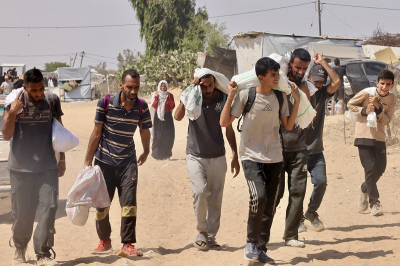
In an era where information travels faster than ever, the deliberate misuse of images and narratives to shape public opinion has become a potent weapon.
A recent and glaring example involves a picture of a sick child in Gaza, falsely portrayed as a victim of starvation caused by Israel. It’s egregious that photos of the 5-year-old boy have been misused to blame Israel for his condition, buffering claims that Israel is starving children.
The fact is that this child suffers from a serious genetic illness. But had Hamas not pilfered billions in financial aid to build up a network of terror, perhaps today there would have been medical facilities in Gaza in which he could be treated. On June 12, Israeli troops coordinated his evacuation from Gaza, along with his mother and brother.
This case exemplifies how fake news is crafted and disseminated to vilify Israel and fuel anti-Israel narratives. The manipulation of this image as demonstrating allegations of famine in Gaza made headlines in major outlets like The New York Times, CNN, Sky News, The Guardian, Daily Mail, Daily Express and others (just in English). It reveals a troubling pattern of media bias, and the distortion of truth to demonize a nation. Even worse, it depicts a lie.
The picture depicts a frail child, seemingly on the brink of death, being comforted by his mother. Widely circulated, it was presented as evidence of a famine in Gaza, with Israel cast as the perpetrator. Far from being the cause of his suffering, Israel facilitated his medical evacuation for treatment. The image, while real, was stripped of its context and repurposed to fit a narrative that falsely accused Israel of causing famine in Gaza.
This deliberate misrepresentation is not an isolated incident but part of a broader strategy to manipulate public perception and demonize Israel.
The exploitation of this child’s image is particularly egregious because it preys on universal empathy for suffering children. Anyone with an ounce of compassion would hesitate to use a sick child’s image in such a manipulative way. Yet, the media’s rush to publish this image without verifying its authenticity suggests gross negligence or intentional bias. The picture’s prominence on the front pages of global media outlets amplified its impact, reaching tens of millions, creating a false narrative in the public consciousness. By the time corrections or retractions are issued — if they are at all — they are often buried in obscurity, unable to undo the damage caused by the initial “report.”
There are other inconsistencies that any serious media outlet should question.
If there was a real starvation, why would the media need to resort to fake or out-of-context images? The answer lies in the absence of actual evidence for widespread starvation. Is there suffering, sure. Are people hungry, no doubt. Are hundreds or thousands of children dying of starvation? Not even close.
Since the Hamas attack and massacre on October 7, 2023, other images have been falsely presented as evidence of Israeli wrongdoing in Gaza. These deliberate misrepresentations are not accidental. The media’s complicity in this propaganda is further evidenced by its reluctance to highlight the suffering caused by Hamas, which uses Palestinian Arab children as human shields for their own agenda. By focusing on fabricated narratives about Israel, the media diverts attention from real humanitarian crises in places like Syria, Yemen, and Iran, where jihadi groups and regimes perpetrate widespread suffering.
In 1989, I was the driver for then Deputy Foreign Minister Benjamin Netanyahu. He came to Atlanta for one meeting with CNN writers and editors, emphasizing the importance of context in reporting on Israel. While he was generally well received, truth, facts, and context are often trumped by the need for ratings. Without context, stories about Israel are easily distorted to fit preconceived biases.
If I had taken and promoted the photo of a child and used that to misrepresent truth or use that child’s image in the cause of some other agenda, I would be sued.
While many anti-Israel voices immediately jump to decry those defending Israel “playing the antisemitism card,” the reality is that the roots of this manipulation lie in a broader antisemitic agenda. The infamous Nazi propaganda chief Joseph Goebbels’ used a strategy of accusing one’s enemy of the very crimes one is committing. In this case, the media, along with entities like the UN and jihadi Islamic groups, accuse Israel of causing Palestinian suffering while ignoring or enabling the actions of those truly responsible. This demonization of Israel is a core element of modern antisemitism, with lies fabricated in a shotgun approach of publishing outrageous headlines and images at such a rapid pace that even if only one or two hit their target, it shapes public opinion before the truth can catch-up.
Moreover, the media’s selective focus on Israel distracts from other global crises. While jihadi groups burn churches in Syria, massacre Druze communities, slaughter Christians across Africa, and devastate civilians in Yemen and Iran, these stories receive far less attention than fabricated narratives about Israel. This double standard reveals a troubling bias, where Israel is consistently singled out for condemnation while other human rights abuses are overlooked.
The situation in Gaza is bad enough. Fifty hostages still remain in captivity, the living among which are facing real starvation. The truth is that if Hamas were to release them all, and release its jihadi grip on two million Gazans, calm, if not peace, could be established. Other than doing nothing to portray this reality, by exploiting vulnerable individuals and ignoring context, the media plays a dangerous role in advancing propaganda that vilifies Israel.
Jonathan Feldstein is President and CEO of the Genesis 123 Foundation and RunforZion.com

















